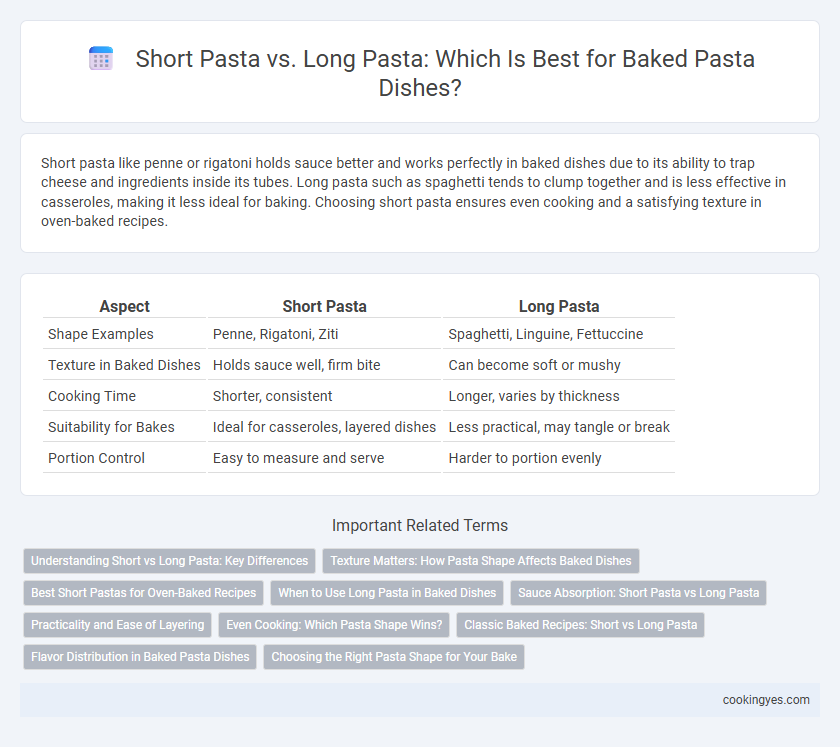Short pasta like penne or rigatoni holds sauce better and works perfectly in baked dishes due to its ability to trap cheese and ingredients inside its tubes. Long pasta such as spaghetti tends to clump together and is less effective in casseroles, making it less ideal for baking. Choosing short pasta ensures even cooking and a satisfying texture in oven-baked recipes.
Table of Comparison
| Aspect | Short Pasta | Long Pasta |
|---|---|---|
| Shape Examples | Penne, Rigatoni, Ziti | Spaghetti, Linguine, Fettuccine |
| Texture in Baked Dishes | Holds sauce well, firm bite | Can become soft or mushy |
| Cooking Time | Shorter, consistent | Longer, varies by thickness |
| Suitability for Bakes | Ideal for casseroles, layered dishes | Less practical, may tangle or break |
| Portion Control | Easy to measure and serve | Harder to portion evenly |
Understanding Short vs Long Pasta: Key Differences
Short pasta varieties such as penne, rigatoni, and ziti excel in baked dishes due to their sturdy shape and ability to hold sauces and cheese within their tubes or ridges, enhancing flavor absorption. Long pasta like spaghetti or linguine tends to be more delicate and can clump or overcook in baked preparations, making it less ideal for casseroles and baked pasta dishes. Selecting short pasta ensures even cooking, better texture retention, and an optimal balance of sauce and pasta in baked meals.
Texture Matters: How Pasta Shape Affects Baked Dishes
Short pasta, such as penne or rigatoni, offers a firm texture that holds up well to baking, creating pockets for sauces and cheeses to cling to, enhancing each bite's richness. Long pasta like spaghetti tends to become softer and less structured in baked dishes, often resulting in a creamier but less distinct texture. Choosing short pasta shapes maximizes texture contrast, making baked pasta dishes more satisfying and flavorful.
Best Short Pastas for Oven-Baked Recipes
Short pasta varieties such as penne, rigatoni, ziti, and cavatappi hold sauce and cheese exceptionally well, making them ideal for oven-baked dishes like casseroles and baked ziti. These shapes provide optimal texture retention and even cooking in the oven, preventing the common sogginess found with longer pastas like spaghetti or linguine. Choosing ridged or tubular short pastas enhances flavor absorption and creates a satisfying bite in baked recipes.
When to Use Long Pasta in Baked Dishes
Long pasta such as spaghetti, lasagna, or bucatini is ideal for layered baked dishes where the noodles act as structural elements, absorbing sauces and flavors while maintaining shape. This variety works well in casseroles like baked spaghetti or lasagna, providing a sturdy yet tender texture after baking at around 350degF for 30-45 minutes. Using long pasta ensures even sauce distribution and a satisfying mouthfeel in oven-baked recipes that rely on noodle integrity and sauce absorption.
Sauce Absorption: Short Pasta vs Long Pasta
Short pasta varieties like penne, rigatoni, and ziti excel in baked dishes due to their ridges and hollow shapes, which trap and absorb rich tomato or cheese-based sauces more effectively. Long pasta such as spaghetti or linguine tends to provide less surface area for sauce adherence, resulting in a lighter coating rather than full absorption. For baked casseroles or layered dishes, short pasta ensures an even distribution of sauce, enhancing flavor intensity and texture.
Practicality and Ease of Layering
Short pasta like penne or rigatoni offers practicality and ease of layering in baked dishes due to its uniform shape and size, allowing even distribution of sauce and fillings. Long pasta, such as spaghetti or fettuccine, can be challenging to layer neatly in casseroles and often requires breaking to fit, potentially disrupting texture. Choosing short pasta enhances structural integrity and ensures consistent baking results in layered pasta casseroles.
Even Cooking: Which Pasta Shape Wins?
Short pasta shapes like penne and rigatoni excel in baked dishes due to their uniform size and hollow structure, promoting even heat distribution and thorough cooking. Long pasta varieties such as spaghetti tend to clump and cook unevenly in casserole-style recipes, resulting in inconsistent texture. Choosing short pasta ensures consistent baking performance and ideal absorption of sauces and cheese.
Classic Baked Recipes: Short vs Long Pasta
Short pasta shapes like penne, rigatoni, and ziti hold sauce better and create a hearty texture ideal for classic baked dishes such as baked ziti or pasta al forno. Long pasta varieties like spaghetti or linguine tend to clump and may not distribute sauce evenly in baked casseroles, making them less suitable for traditional baked recipes. Choosing short pasta ensures consistent heat penetration and an evenly baked, flavorful result in oven dishes.
Flavor Distribution in Baked Pasta Dishes
Short pasta shapes like penne and rigatoni excel in baked dishes by capturing sauce and cheese within their ridges and hollow centers, ensuring even flavor distribution throughout each bite. Long pasta varieties such as spaghetti or linguine tend to clump together when baked, limiting sauce penetration and causing uneven taste. Choosing short pasta for baked casseroles enhances the infusion of rich, savory flavors into every piece, creating a consistently flavorful dish.
Choosing the Right Pasta Shape for Your Bake
Short pasta shapes like penne, rigatoni, or ziti are ideal for baked dishes due to their ability to hold sauce and cheese in each tube, ensuring even flavor distribution. Long pasta such as spaghetti or linguine tends to clump and may not cook evenly in casseroles, making it less suitable for baking. Selecting the right pasta shape enhances texture and prevents sogginess, creating the perfect baked pasta dish.
Short pasta vs long pasta for baked dishes Infographic

 cookingyes.com
cookingyes.com